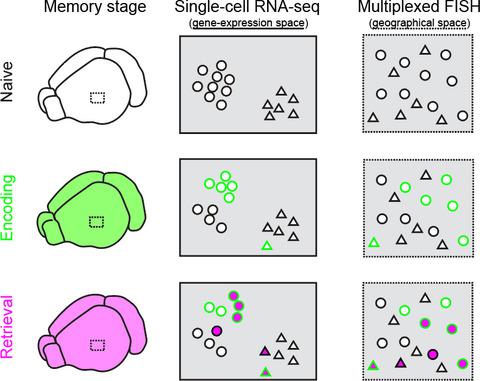当前位置:
X-MOL 学术
›
J. Neurochem.
›
论文详情
Our official English website, www.x-mol.net, welcomes your
feedback! (Note: you will need to create a separate account there.)
Elucidating memory in the brain via single-cell transcriptomics
Journal of Neurochemistry ( IF 4.2 ) Pub Date : 2020-11-23 , DOI: 10.1111/jnc.15250 Kaitlin E Sullivan 1 , Rennie M Kendrick 1 , Mark S Cembrowski 1, 2, 3, 4
Journal of Neurochemistry ( IF 4.2 ) Pub Date : 2020-11-23 , DOI: 10.1111/jnc.15250 Kaitlin E Sullivan 1 , Rennie M Kendrick 1 , Mark S Cembrowski 1, 2, 3, 4
Affiliation

|
Elucidating the neural mechanisms of memory in the brain is a central goal of neuroscience. Here, we discuss modern-day transcriptomics methodologies, and how they are well-poised to revolutionize our insight into memory mechanisms at unprecedented resolution and throughput. Focusing on the hippocampus and amygdala, two regions extensively examined in memory research, we show how single-cell transcriptomics technologies have been leveraged to understand the naïve state of these brain regions. Building upon this foundation, we show that these technologies can be applied to single-trial learning paradigms to comprehensively identify molecules and cells that participate in the encoding and retrieval of memory. Transcriptomics also provides an opportunity to understand the cell-type organization of the human hippocampus and amygdala, and due to conservation of these brain regions between humans and rodents, to infer behavioral and causal contributions in the human brain by leveraging rodent cell-type homologies and interventions. Ultimately, such transcriptomic technologies are poised to usher in a qualitatively novel understanding of memory in the brain.
中文翻译:

通过单细胞转录组学阐明大脑中的记忆
阐明大脑记忆的神经机制是神经科学的中心目标。在这里,我们讨论了现代转录组学方法论,以及它们是如何做好准备以革命性的方式以前所未有的分辨率和通量革新我们对存储机制的见解。着眼于海马和杏仁核这两个在记忆研究中广泛研究的区域,我们展示了如何利用单细胞转录组学技术来了解这些大脑区域的幼稚状态。在此基础上,我们表明这些技术可以应用于单次尝试学习范例,以全面识别参与记忆编码和检索的分子和细胞。转录组学还为了解人类海马和杏仁核的细胞类型组织提供了机会,由于保护了人类和啮齿动物之间的这些大脑区域,因此可以利用啮齿动物的细胞类型同源性和干预来推断人类大脑中的行为和因果贡献。最终,这种转录组学技术有望对大脑的记忆产生质的新颖理解。
更新日期:2020-11-23
中文翻译:

通过单细胞转录组学阐明大脑中的记忆
阐明大脑记忆的神经机制是神经科学的中心目标。在这里,我们讨论了现代转录组学方法论,以及它们是如何做好准备以革命性的方式以前所未有的分辨率和通量革新我们对存储机制的见解。着眼于海马和杏仁核这两个在记忆研究中广泛研究的区域,我们展示了如何利用单细胞转录组学技术来了解这些大脑区域的幼稚状态。在此基础上,我们表明这些技术可以应用于单次尝试学习范例,以全面识别参与记忆编码和检索的分子和细胞。转录组学还为了解人类海马和杏仁核的细胞类型组织提供了机会,由于保护了人类和啮齿动物之间的这些大脑区域,因此可以利用啮齿动物的细胞类型同源性和干预来推断人类大脑中的行为和因果贡献。最终,这种转录组学技术有望对大脑的记忆产生质的新颖理解。











































 京公网安备 11010802027423号
京公网安备 11010802027423号